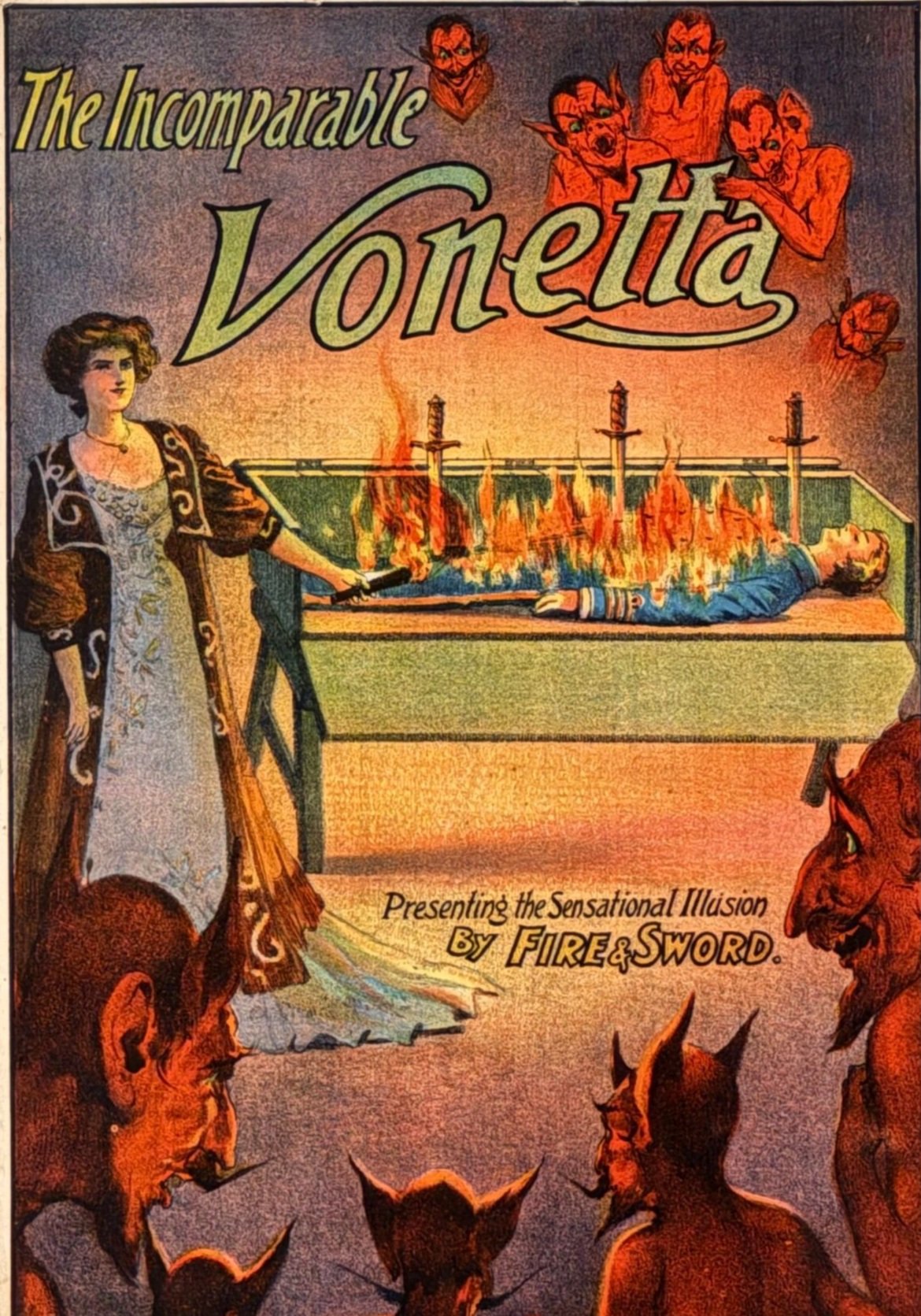
The Mysterious Woman of MAgic
By William Pack | Magician, Historian, and Educator, https://libraryprogramming.com/
Vonetta
(Etty Thompson / Winifred Etta Travers / Countess de Russe)
B. August 14, 1878 – D. June 13, 1964
Researching a magician’s life can often yield more questions than answers. Throughout the history of performance, it has been the performer’s prerogative to create a personal narrative that was at least a misdirection from their true self or, at most, a completely fabricated backstory. Vonetta has done just this—leaving us a tangled web.
Born in North Yorkshire, Vonetta was a woman of many names. In a newspaper profile, she said her maiden name was Etta Ion, but it was really Etty Thompson. When she married Thomas Monaghan (himself a man of many names: T. Vincent Paul, T.M. Paul, Vincent M. Paul) on October 11, 1904, she changed her name to Winifred Etta Travers. But that wasn’t the end of it.
Monaghan managed the Empire Theater in Shildon (England). Etta performed in the pantomimes. She also sang and danced while her husband provided an accompanying magic lantern show.
In 1906, they developed a new act of dances, magic, 24 changes of costumes, and a series of poses representing classical studies such as “The Birth of Venus,” “The Bath of Psyche,” and “Cleopatra.” The show required a cast of 12. The first audition performance was a disaster and resulted in no bookings. After more rehearsals, a second performance triumphed. Vonetta (originally Von Etta) started her career as a top-of-the-bill performer.
Theatrical newspaper, The Hippodrome, covered her show in February 1907: “Mademoiselle Von Etta, the illusionist who combines the mystery of Maskelyne with the quickness of Fregoli, is providing the current sensations at that wonderland of the west – the London Hippodrome. Von Etta’s illusions are both original and bewildering, and the box trick is as mystifying as it is ingenious. The charm of the Von Etta surprises lies not only in their unsolvable character, but the delightful manner in which they are presented, and the personal beauty of the dainty feminine wizard.”
About the box trick:
The Conjurers’ Monthy Magazine March 1907: “Mlle. Vonetta, who proclaims herself as the World’s Only Lady Illusionist, has made quite a hit at the London Hippodrome. The Illusion most commented on by the press is the one which she enters a coffin-shaped box that rests on two stools; this box then commences to float in midair, and whilst doing this feat, the young lady rushes through the audience, coming from the front of the house. She changes her dresses twelve different times in ten minutes, which is something very woman-like, and cannot help but create comment.”
The charm of the Von Etta
surprises lies not only in their
unsolvable character,
but the delightful manner in which they are presented,
and the personal beauty
of the dainty feminine wizard.
In an article, Vonetta told of a car accident and injury that kept her from performing for ten months until August 1910. She returned to her act. A few weeks later, for some unknown reason, she performed under a different name, Countess de Russe. She worked intermittently during the next four years.
With the outbreak of World War I, her career ended as her assistants went to work in the war effort. She served as a nurse in the Voluntary Aid Detachment. After the war ended, she had minor roles in a few movies. In the 1920s, Vonetta, under the name E. W. Travers, rented films to theaters and other venues.
In 1922, Vonetta made a brief two-performance return to the Variety stage under the name Countess Wilet & Company. Etta also worked as a dance teacher in the late 1920s and early 1930s, although she did continue to perform magic elsewhere. Her business card offered Madame Vonetta, Scotland’s only Lady Magician, Banquets and Children’s Parties a Specialty.
In 1924, she received an honorary membership to the Scottish Conjurers’ Association and performed at some of their functions.
In the 1930s and 40s, she diversified into another commercial activity as a purveyor of fur coats, clothing, and costumes. As Etta Travers, she continued the trade at various addresses. In her later years, she lived with her son. She died of congestive heart failure in 1964.


